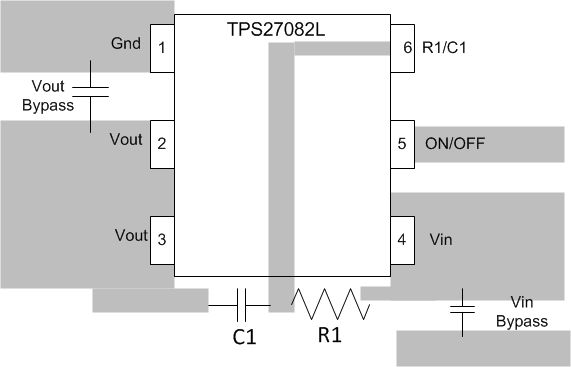SLVSBR5C December 2012 – June 2015 TPS27082L
PRODUCTION DATA.
- 1 Features
- 2 Applications
- 3 Description
- 4 Revision History
- 5 Pin Configuration and Functions
- 6 Specifications
- 7 Detailed Description
-
8 Application and Implementation
- 8.1 Application Information
- 8.2 Typical Application
- 8.3
System Examples
- 8.3.1 TFT LCD Module Inrush Current Control
- 8.3.2 Standby Power Isolation
- 8.3.3 Boost Regulator With True Shutdown
- 8.3.4 Single Module Multiple Power Supply Sequencing
- 8.3.5 Multiple Modules Interdependent Power Supply Sequencing
- 8.3.6 Multiple Modules Interdependent Supply Sequencing Without a GPIO Input
- 9 Power Supply Recommendations
- 10Layout
- 11Device and Documentation Support
- 12Mechanical, Packaging, and Orderable Information
Package Options
Mechanical Data (Package|Pins)
- DDC|6
Thermal pad, mechanical data (Package|Pins)
Orderable Information
10 Layout
10.1 Layout Guidelines
For best operational performance of the device, use good PCB layout practices, including:
- VIN and VOUT traces should be as short and wide as possible to accommodate for high current.
- The VIN pin should be bypassed to ground with low ESR ceramic bypass capacitors. The typical recommended bypass capacitance is 1-μF ceramic with X5R or X7R dielectric. This capacitor should be placed as close to the device pins as possible.
- The VOUT pin should be bypassed to ground with low ESR ceramic bypass capacitors. The typical recommended bypass capacitance is one-tenth of the VIN bypass capacitor of X5R or X7R dielectric rating. This capacitor should be placed as close to the device pins as possible.
10.2 Layout Example
 Figure 23. Layout Diagram
Figure 23. Layout Diagram
10.3 Thermal Considerations
For higher reliability it is recommended to limit TPS27082L IC’s die junction temperature to less than 125°C. The IC junction temperature is directly proportional to the on-chip power dissipation. Use the following equation to calculate maximum on-chip power dissipation to restrict the die junction temperature target to safe limits:

where
- TJ(MAX) is the target maximum junction temperature,
- TA is the operating ambient temperature,
- and RθJA is the package junction to ambient thermal resistance.
10.3.1 Improving Package Thermal Performance
The package RθJA value under standard conditions on a High-K board is available in Dissipation Ratings. RθJA value depends upon the PCB layout. An external heat sink and/or a cooling mechanism like a cold air fan can help reduce RθJA and thus improving device thermal capability. Refer to TI’s design support web page at www.ti.com/thermal for a general guidance on improving device thermal performance.